People just starting out with organizing often ask, “What’s the best way to organize my home?” In my opinion, it’s by using zones.
Why? When you organize by zones, you save time finding (and replacing) things. It’s the most efficient way to arrange items in your home and helps keep your home neat and tidy.
Ready to get “in the zone?” I’ve got some helpful tips for you…read on! I’ve even included an infographic of common organizing zones to help you get started.
You can save these tips for later by entering your info below. I’ll send them straight to your inbox!
Have tips sent to email to save for later:
What is an Organizing Zone?
Simply put, an organizing zone is a space where we store a category of items. Imagine a library with its categories (zones) for fiction, non-fiction, reference, etc. Those zones make it easy to locate what you’re looking for. If you had books shoved onto shelves in no particular order, it would take you forever to find anything.
While it’s possible to have a home that looks organized without the use of specific zones, I feel that zone organizing takes things one step further…into blissful efficiency. And to me, part of having a peaceful, balanced life is being able to find anything I want in my house without having to search.
How Do I Create Zones in My House?
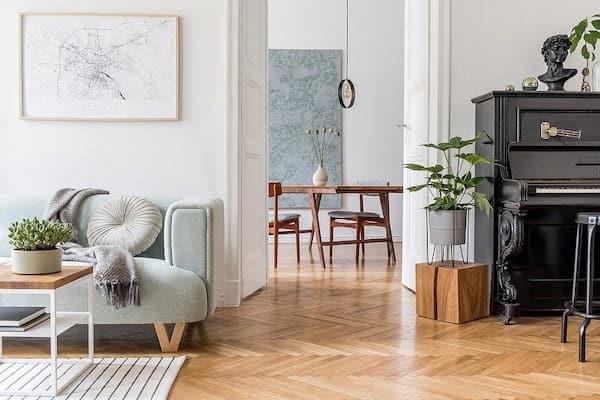
Organizing zones are tailored to your lifestyle and how you use the items in your home. To figure out which zones you need (and where they should be), I recommend these steps:
Step 1: Walk through each room in your house and determine its purpose.
Some rooms will have one clear purpose; others will have more than one. Is your kitchen used primarily for cooking, or is it also where you eat and entertain? Does your family room double as a playroom? Is your laundry room just for laundry, or is it also a utility closet for brooms, mops and cleaning supplies?
Step 2. Determine what should be stored in each room based on its purpose.
When a room has a clear purpose, it should be relatively easy to determine what you’ll store there.
For instance: cookware, dinnerware and appliances belong in the kitchen. DVDs, video games, books, board games and toys might belong in the family room. Tech gadgets, chargers, printers, computers, routers and office supplies are stored in the home office. And so on.
Step 3. Assign zones for the items.
Once you’ve established what belongs in each space, break things down further into zones, based on type of item and how it’s used. Aim for efficiency.
For instance:
- All DVDs go in the media cabinet closest to the DVD player.
- All board games are housed in the storage ottoman so the kids can easily access them, play with them nearby and put them away.
- Glassware gets stored in the cabinet closest to the refrigerator, so that cups are closest to milk, juice and water.
- Arrange blouses in the closet by long-sleeved and short-sleeved, in rainbow order. This will save you SO MUCH TIME getting ready in the morning!
IMPORTANT NOTE: Zones are the best way to organize your home…but only when you stick to them.
When you let things shift out of their zones, you’ll notice that you start to forget where you’ve put things. Piles begin to form because items don’t have a clear “place” anymore.
Suddenly, your house doesn’t feel as organized.
If this happens, take a deep breath and re-establish the zones. Organizing is a practice, not a one-time project!
Step 4. Organize the contents of each zone for maximum efficiency.
Once you’ve identified what goes in each zone, you’ll want to organize it neatly. This is where functional furniture, storage pieces, bins and baskets come in handy. And LABEL, LABEL, LABEL! More on this below.
Keep reading for helpful organizing tips for specific rooms and zones!
Infographic: Common Home Organizing Zones
To help inspire you in creating zones that work for your lifestyle, here’s a handy infographic with common home organizing zones. PIN THIS TO SAVE FOR LATER:
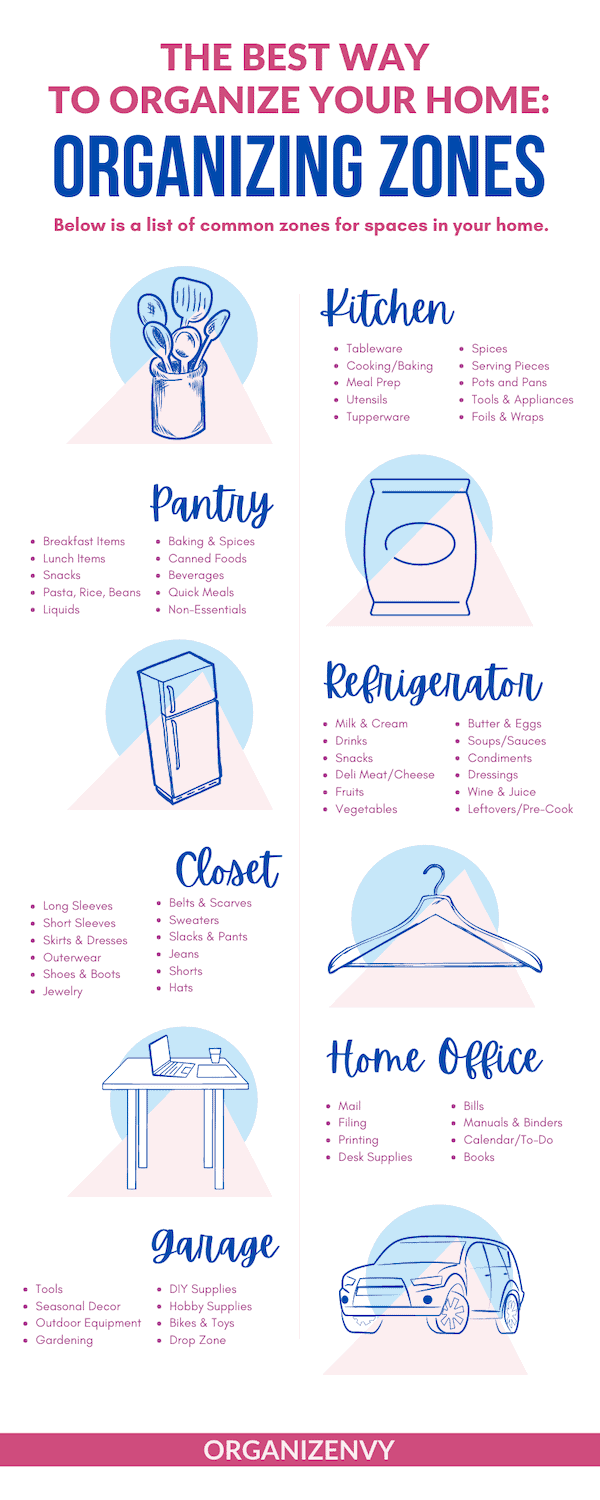
Next, I’ll discuss each of these spaces and how zones can work to increase efficiency, productivity, and most of all…create a peaceful environment!
Kitchen Zone Organization
The kitchen is one area where proper placement of zones is SO helpful. The goal is to reduce the number of steps (and the amount of time) it takes to complete tasks.
In the image below, I’ve identified kitchen zones that maximize efficiency within the layout of the space:
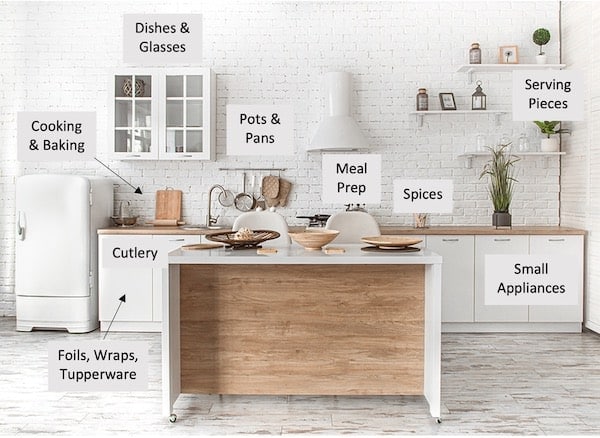
Take note of the following in this example:
- Glassware is next to the refrigerator so it’s easy to get a cup of juice, water or milk.
- Dishes and cutlery are near the sink (or dishwasher) for efficient cleaning and storage.
- Pots and pans are close to the stove.
- A meal prep space (where you’ll store cutting boards and knives) is close to the stove.
- Spices should be stored close to meal prep and stove so you can easily access them while cooking.
Make the most of the space you have in your cabinets and on your countertops with organizers like racks, Lazy Susans, bins and baskets, cutlery trays and more.
For helpful organizing tips and product recommendations for specific areas of the kitchen, check out:
- 30 Space-Saving Ways to Organize a Small Kitchen
- 15 Space-Saving Ways to Store Pots and Pans in the Kitchen
- Spice Storage Ideas for Small Kitchens
- Gorgeous Ways to Organize Glassware, Cups and Bottles
- Simple Ways to Organize Kitchen Drawers for Maximum Efficiency
- 12 Cozy Ways to Organize Your Kitchen Coffee Station
- The Easiest Way to Organize Under the Kitchen Sink
Pantry Zone Organization
In the pantry, the goal of zone organization is to make it easy to find and access everything. Keeping an organized pantry will prevent you from accidentally over-buying items you have but misplaced. It also helps you remember to consume items before they expire. (Both of which save money in the long run.)
My pantry zones include breakfast items, snacks, baking ingredients, staples like pasta and rice, quick meals and canned goods.
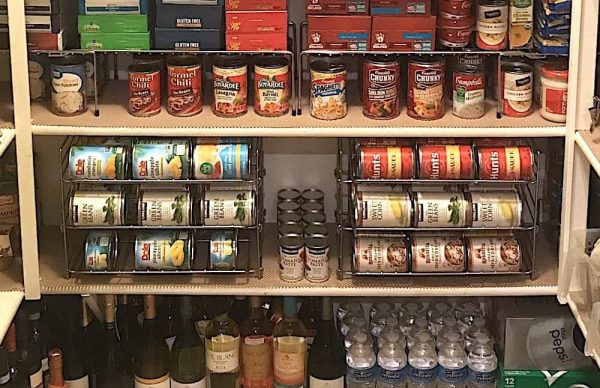
I group items that are used together, like oils and vinegars, bread and peanut butter, pastas and sauces. This makes it really easy for me to find and grab them off the shelf at the same time.
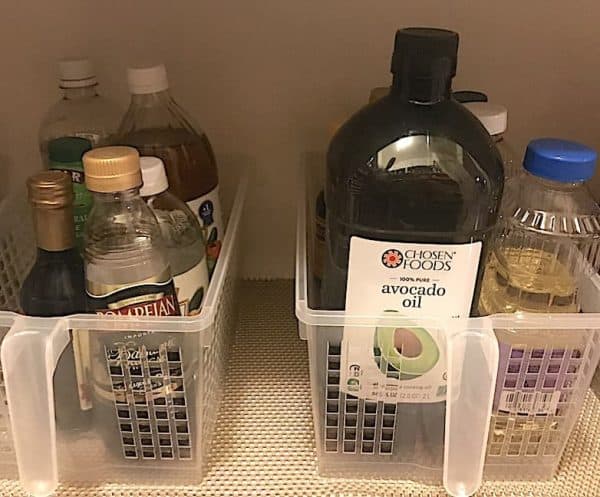
For helpful tips and product recommendations on organizing items in your pantry, check out these articles:
- How to Organize a Walk-In Pantry in a Weekend
- 12 Life-Changing Ways to Organize With a Lazy Susan
- Organize Vitamins, Supplements and Medications in 4 Steps
Refrigerator Zone Organization
Tired of the mess in your fridge? This is another great space for zones! Which zones you assign will depend on the types of food you store, but generally speaking you might want areas for:
- Milk, cream, juice and other large bottles
- Water bottles, soda/canned beverages
- Dairy and eggs
- Deli meats and cheeses
- Snacks (yogurt, string cheese, fruit cups, pudding, etc.)
- Condiments, dressings, marinades
- Soups and sauces
- Meal prep (raw meat, poultry, fish)
- Leftovers
- Fruits and vegetables
I made the zones in my fridge really easy for everyone in the house to see by using clear, handled bins and vinyl labels I made with a Cricut.
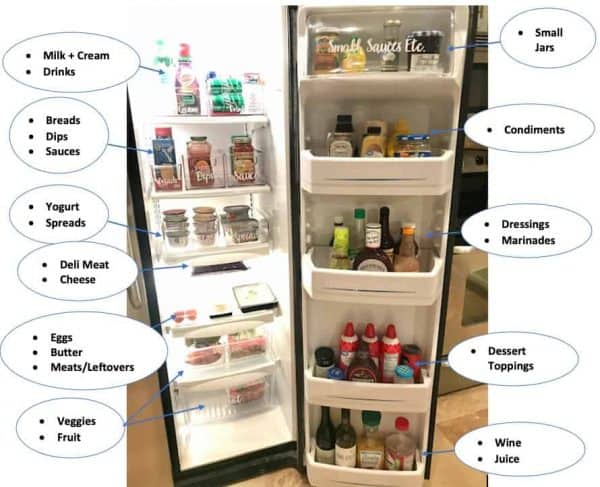
You can apply the same process to a freezer, too. Assign zones for beef and poultry, frozen meals, fruits and vegetables, treats and so on.
For helpful tips and product recommendations for refrigerator and freezer organization, check out:
Closet Zone Organization
Whether you have a reach-in closet, a walk-in closet or an armoire, you can organize the contents in zones. In my closet, clothes are organized together by type (long-sleeved shirts, short-sleeved shirts, sweaters, dresses, skirts, slacks, jeans, shorts) and by color in rainbow order.
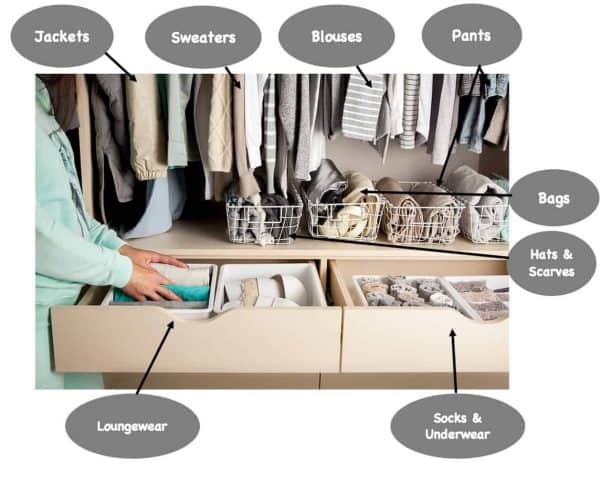
This might sound a bit obsessive, but I can practically dress myself in the dark because I know where every piece of clothing is. I encourage you to try it and see if it works for you!
For clothing that you fold and store on shelves or in drawers, try file-folding them in bins or drawer organizers. You won’t believe how much space you save, and how easy it is to find that vintage t-shirt or your favorite jeans.
Learn how to file-fold clothes step by step here!
For helpful tips and product recommendations for organizing closets and clothes, check out:
- 11 Easy DIY Closet Organizing Ideas Anyone Can Do
- Easy DIY Bedroom Organization Tips and Tricks
- 5 Amazing Tips for Organizing an Armoire
- How to Organize a Teen’s Bedroom
- 11 Beautiful Baby and Nursery Organization Tips
Home Office Zone Organization
Is your home office the place where papers pile up? Where mail and bills get lost? Where dried up, cap-less pens are sprinkled like ice cream sundae toppings across the desk?
Time for zones! Focus on creating structured areas for incoming and outgoing mail, bills, filing, shredding and office supplies. Use desk accessories to organize the top of your desk, install drawer organizers, bins for shelves and boxes for cabinets. And LABEL EVERYTHING.
For helpful tips on home office storage, including product recommendations, check out:
- How to Beautifully Organize Home Office Supplies
- 20 Cable Storage and Organization Tips to Improve Your Life
- Easy Office Cabinet Organizing Hack
- Organize Chargers and Cables in a Cutlery Tray
Garage Zone Organization
Don’t forget the garage! This space is seriously in need of zone organizing, too, especially if you store a lot of items here (like I do).
In our recent garage reorganization project, my husband and I installed wall-to-wall (almost) steel shelving to accommodate dozens of bins. We are DIYers, hobbyists and sports parents, and our garage is pretty much the only storage space we have.
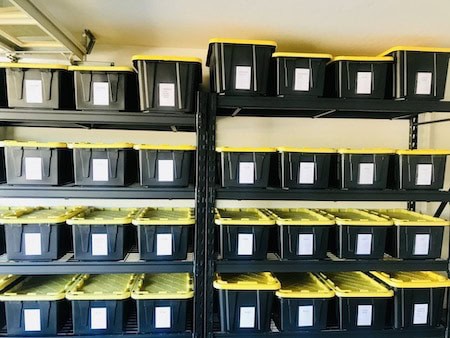
To make it easy to find everything, I assigned a shelf or two to a specific zone: seasonal decor, DIY supplies, camping gear, sports gear, etc.
I included a 4×6 index card label (printed from the computer) with the contents of each bin on the front:
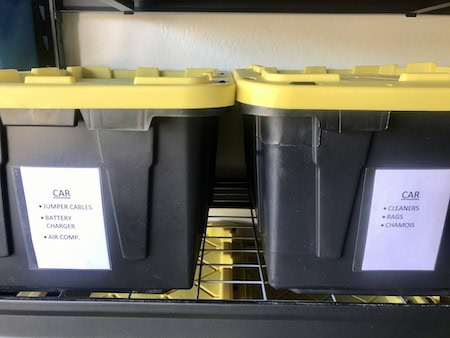
For helpful garage organization tips and product recommendations, check out:
16 Clever Ways to Organize Your Garage on the Cheap
Zone Organization: Final Thoughts
Now that you’ve seen my zone organization ideas, I hope I’ve inspired you to see if zones are the best way to organize for you, too! Remember, there’s no “right” way to organize…whatever system works for you and your household is the one you should use.
More helpful articles:
- 10 Simple Steps: A Beginner’s Guide to Organizing
- The Best Way to Organize a Messy Room
- The Biggest Organizing Mistakes (and How to Fix Them)
- How to Get Organized For a Move: 14 Fantastic Tips
Happy organizing!